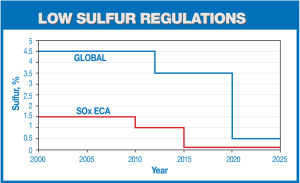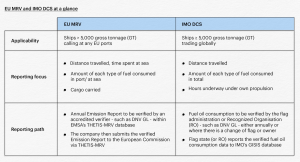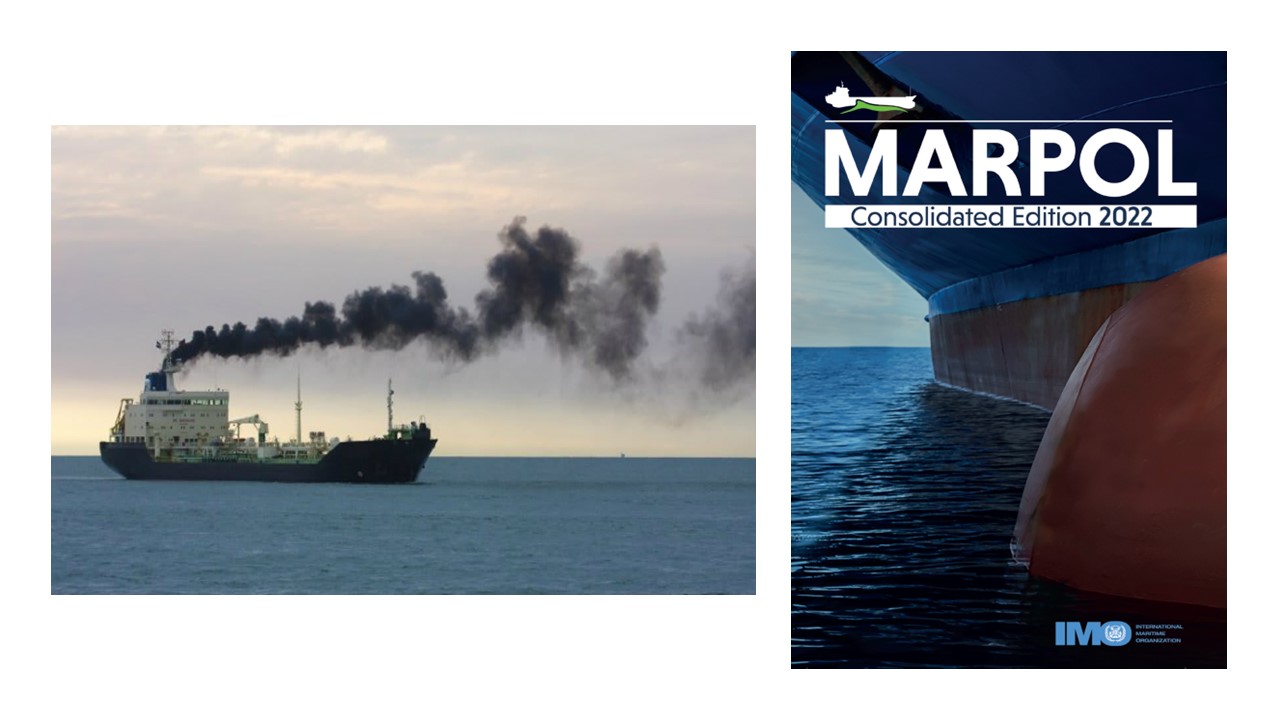
The International Convention for the Prevention of Pollution from Ships (MARPOL) is a critical global initiative that aims to minimize maritime pollution and protect the world’s oceans and marine ecosystems. Annex VI, officially known as the “Prevention of Air Pollution from Ships,” is a vital component of this convention. Introduced in 1997 and enforced in 2005, Annex VI sets forth stringent regulations and guidelines to limit harmful emissions from ships, specifically targeting the release of sulfur oxides (SOx), nitrogen oxides (NOx), ozone-depleting substances (ODS), and volatile organic compounds (VOCs).
As a response to growing concerns about air pollution, climate change, and the detrimental effects on human health and the environment, Annex VI has been revised and updated several times to reflect technological advancements and the latest scientific understanding. The Energy Efficiency Design Index (EEDI) and the Ship Energy Efficiency Management Plan (SEEMP) are notable additions, aiming to enhance the energy efficiency of ships and reduce greenhouse gas emissions.
Through international cooperation and the diligent efforts of the International Maritime Organization (IMO) and its member states, Annex VI has proven to be a valuable instrument in the fight against air pollution from shipping. The global community’s commitment to this cause has led to cleaner air, healthier ecosystems, and a more sustainable future for the shipping industry.
As of December 2024, the International Maritime Organization (IMO) has implemented several amendments to MARPOL Annex VI to enhance the prevention of air pollution from ships. Below is the revised structure of MARPOL Annex VI, incorporating these updates:
Chapter 1 – General
- Regulation 1: Application
- Regulation 2: Definitions
- Regulation 3: Exceptions and Exemptions
- Regulation 4: Equivalents
Chapter 2 – Survey, Certification, and Means of Control
- Regulation 5: Surveys
- Regulation 6: Issue or Endorsement of a Certificate
- Regulation 7: Issue or Endorsement of a Certificate by Another Party
- Regulation 8: Form of Certificate
- Regulation 9: Duration and Validity of Certificate
- Regulation 10: Port State Control on Operational Requirements
- Regulation 11: Detection of Violations and Enforcement
- Regulation 12: Requirements for Platforms and Drilling Rigs
Chapter 3 – Requirements for Control of Emissions from Ships
- Regulation 13: Nitrogen Oxides (NOₓ)
- Regulation 14: Sulphur Oxides (SOₓ) and Particulate Matter
- Regulation 15: Volatile Organic Compounds (VOCs)
- Regulation 16: Shipboard Incineration
- Regulation 17: Reception Facilities
- Regulation 18: Fuel Oil Availability and Quality
Chapter 4 – Regulations on Energy Efficiency for Ships
- Regulation 19: Application
- Regulation 20: Attained Energy Efficiency Design Index (Attained EEDI)
- Regulation 21: Required Energy Efficiency Design Index (Required EEDI)
- Regulation 22: Ship Energy Efficiency Management Plan (SEEMP)
- Regulation 22A: Collection and Reporting of Ship Fuel Oil Consumption Data
- Regulation 23: Attained Energy Efficiency Existing Ship Index (Attained EEXI)
- Regulation 24: Required Annual Operational Carbon Intensity Indicator (Required Annual Operational CII)
- Regulation 25: Operational Carbon Intensity Rating
- Regulation 26: Ship Operational Carbon Intensity Plan
- Regulation 27: Verification of Ship Fuel Oil Consumption Data and Operational Carbon Intensity
- Regulation 28: Annual Reporting to the Organization and Record Requirements
Chapter 5 – Verification of Compliance with the Provisions of This Annex
- Regulation 29: Verification of Compliance
Notable Amendments:
Mediterranean Sea Emission Control Area (ECA): Effective 1 May 2025, the Mediterranean Sea is designated as an ECA for sulphur oxides (SOₓ) and particulate matter, requiring ships to use fuel oil with a sulphur content not exceeding 0.10% m/m or to employ equivalent methods to reduce emissions.
Bunker Delivery Note (BDN) Requirements: From 1 May 2024, the BDN must include the flashpoint of the fuel oil or a statement confirming that the flashpoint has been measured at or above 70°C, enhancing safety and compliance verification.
Carbon Intensity Indicator (CII) Reporting: Amendments to Appendix IX require the inclusion of attained and required CII values, the CII rating, and the attained Energy Efficiency Existing Ship Index (EEXI) in data submitted to the IMO Ship Fuel Oil Consumption Database, effective 1 May 2024.
These amendments reflect the IMO’s ongoing commitment to reducing air pollution and greenhouse gas emissions from international shipping, promoting environmental protection and energy efficiency.
MARPOL Annex VI
In 1997, a new annex was added to the International Convention for the Prevention of Pollution from Ships (MARPOL). The Prevention of Air Pollution from Ships (Annex VI) regulations seek to minimize airborne emissions from ships (SOx, NOx, ODS, VOC shipboard incineration) and their contribution to local and global air pollution and environmental problems. Annex VI entered into force in 2005, and a revised Annex VI with significantly tightened emissions limits entered into force on 1 July 2010.
Additionally, Annex VI includes several appendices detailing certificates, test cycles, criteria for emission control areas, and other relevant information.
It’s important to note that the regulations have been renumbered and expanded in recent amendments, particularly with the inclusion of energy efficiency and carbon intensity measures. For the most current and detailed information, refer to the official IMO documentation, such as Resolution MEPC.328(76), which contains the 2021 Revised MARPOL Annex VI.
Chapter 1 – General (MARPOL Annex VI)
Regulation 1 – Application
Specifies the scope of Annex VI, outlining its applicability to all ships, fixed and floating platforms, and drilling rigs, except where specific exemptions are granted.
Regulation 2 – Definitions
Provides clear definitions for key terms used throughout Annex VI, including “Emission Control Areas (ECAs),” “Nitrogen Oxides (NOx),” “Sulphur Oxides (SOx),” and “Energy Efficiency Design Index (EEDI).”
Regulation 3 – Exceptions and Exemptions
Details scenarios where the requirements of Annex VI do not apply, such as emergencies or cases where compliance is impracticable, along with exemptions for specific ship types or operations under agreed conditions.
Regulation 4 – Equivalents
Allows for the use of alternative methods or technologies that achieve equivalent emission reductions, provided they are approved by the Administration.
This chapter establishes the foundation for interpreting and applying the provisions of Annex VI.
Chapter 2 – Survey, Certification, and Means of Control (MARPOL Annex VI)
Regulation 5 – Surveys
Requires ships to undergo specific surveys (initial, renewal, annual, intermediate) to ensure compliance with Annex VI provisions regarding emissions and energy efficiency.
Regulation 6 – Issue or Endorsement of a Certificate
Details the process for issuing the International Air Pollution Prevention (IAPP) Certificate after successful completion of required surveys.
Regulation 7 – Issue or Endorsement of a Certificate by Another Party
Allows certificates to be issued or endorsed by a Party to MARPOL other than the ship’s flag state, with mutual agreement.
Regulation 8 – Form of Certificate
Specifies the format and information required for the IAPP Certificate to ensure consistency and uniformity.
Regulation 9 – Duration and Validity of Certificate
Defines the validity period of certificates and the conditions under which they remain valid or are invalidated (e.g., modifications, survey failures).
Regulation 10 – Port State Control on Operational Requirements
Grants authorities the right to inspect ships in ports to verify compliance with operational requirements of Annex VI.
Regulation 11 – Detection of Violations and Enforcement
Establishes mechanisms for identifying, reporting, and enforcing penalties for violations of air pollution prevention measures.
Regulation 12 – Requirements for Platforms and Drilling Rigs
Extends Annex VI requirements to cover emissions from fixed and floating platforms and drilling rigs, ensuring they meet compliance standards.
This chapter ensures robust systems for monitoring, verifying, and enforcing compliance with Annex VI regulations.
Chapter 3 – Requirements for Control of Emissions from Ships (MARPOL Annex VI)
Regulation 13 – Nitrogen Oxides (NOx)
Sets limits on NOx emissions based on engine type and installation date, categorized into Tiers (Tier I, II, III) with increasingly stringent limits for Emission Control Areas (ECAs).

As of the end of 2022, four established NECAs exist: the Baltic Sea, the North Sea, the North American ECA, and the United States Caribbean Sea ECA. By implementing more stringent NOx emission standards within these areas, Regulation 13 contributes to improving air quality and protecting sensitive marine ecosystems.
Regulation 14 – Sulphur Oxides (SOx) and Particulate Matter
Imposes limits on the sulphur content in fuel oil used onboard ships to reduce SOx emissions and associated particulate matter. Tighter limits apply in ECAs (0.10% sulphur) compared to the global limit (0.50% sulphur).

Regulation 15 – Volatile Organic Compounds (VOCs)
Requires controls to minimize VOC emissions from tankers during loading, storing, and transportation of crude oil. Ports and terminals are also encouraged to provide VOC management plans.
Regulation 16 – Shipboard Incineration
Prohibits incineration of certain substances (e.g., polychlorinated biphenyls, cargo residues) onboard ships and requires incinerators to meet specified performance standards. MARPOL Annex VI regulates shipboard incineration to reduce harmful emissions, including SOx, NOx, dioxins, and particulate matter. It prohibits incineration of specific materials, such as cargo residues, PCBs, heavy metal-laden garbage, halogenated petroleum products, sewage sludge, and sludge oil. Incineration is also banned in ports, harbours, estuaries, and Emission Control Areas (ECAs). Ship incinerators must meet approved design and operational standards to minimize environmental impact.
Regulation 17 – Reception Facilities
Mandates that ports and terminals provide adequate facilities for the reception of ship-generated waste, including residues from exhaust gas cleaning systems (scrubbers).
Regulation 18 – Fuel Oil Availability and Quality
MARPOL Annex VI mandates the use of safe, high-quality fuel oil onboard ships to ensure efficient, environmentally responsible operations and prevent safety risks. Fuel suppliers must provide a “Bunker Delivery Note” (BDN) detailing sulfur content, density, viscosity, and other key characteristics, adhering to ISO 8217:2017 or later standards. Regulation 15 prohibits fuel oil with excess sulfur, inorganic acid, or used lubricants, ensuring compliance and minimizing environmental impact.
These regulations aim to reduce emissions from ships and mitigate their environmental impact, particularly in ECAs and sensitive regions.
Chapter 4 – Regulations on Energy Efficiency for Ships (MARPOL Annex VI)
Regulation 19 – Application
Defines the scope of energy efficiency measures, applying to specific ship types and sizes engaged in international voyages.
Regulation 20 – Attained Energy Efficiency Design Index (Attained EEDI)
Requires new ships to calculate their attained EEDI, reflecting the ship’s energy efficiency performance and adherence to regulatory standards.
Regulation 21 – Required Energy Efficiency Design Index (Required EEDI)
Sets minimum energy efficiency standards (Required EEDI) for new ships, becoming stricter over time to encourage design improvements.
Regulation 22 – Ship Energy Efficiency Management Plan (SEEMP)
Mandates ships to develop and implement a SEEMP, outlining operational measures to improve energy efficiency and reduce greenhouse gas emissions.
Regulation 22A – Collection and Reporting of Ship Fuel Oil Consumption Data
Introduces a mandatory system for collecting and reporting ship fuel oil consumption data, including information on distance traveled and cargo carried.
Regulation 23 – Attained Energy Efficiency Existing Ship Index (Attained EEXI)
Requires existing ships to calculate and comply with the Attained EEXI, an equivalent to the EEDI, to improve energy efficiency standards for older vessels.
Regulation 24 – Required Annual Operational Carbon Intensity Indicator (Required Annual Operational CII)
Establishes targets for annual carbon intensity reductions, measured as CO₂ emissions per unit of transport work (e.g., gram CO₂ per ton-mile).
Regulation 25 – Operational Carbon Intensity Rating
Assigns annual carbon intensity ratings (A to E) based on the ship’s operational CII, with poor ratings triggering corrective actions.
Regulation 26 – Ship Operational Carbon Intensity Plan
Requires ships to maintain an operational plan outlining measures to achieve and maintain compliance with CII targets and improve ratings.
Regulation 27 – Verification of Ship Fuel Oil Consumption Data and Operational Carbon Intensity
Sets guidelines for verifying the accuracy of reported fuel oil consumption and operational CII, ensuring data integrity and regulatory compliance.
Regulation 28 – Annual Reporting to the Organization and Record Requirements
Mandates the submission of verified data on fuel oil consumption and CII performance to the IMO and requires ships to keep detailed records for inspection.
This chapter focuses on improving energy efficiency and reducing carbon intensity in both new and existing ships, aligning the maritime sector with global decarbonization goals.
Chapter 5 – Verification of Compliance with the Provisions of This Annex (MARPOL Annex VI)
Regulation 29 – Verification of Compliance
Establishes the framework for verifying that ships comply with the requirements of MARPOL Annex VI. This includes inspections, audits, and reviews of ship documentation, certificates, and operational practices. Authorities are empowered to confirm compliance through port state control measures, flag state surveys, and additional monitoring mechanisms as necessary.
This regulation ensures accountability and enforces adherence to the emission reduction and energy efficiency standards outlined in the annex.
MARPOL Annex VI addresses the monitoring and reporting of energy efficiency for ships of 5,000 gross tonnage and above. This regulation aims to enhance transparency and promote data-driven decision-making in the shipping industry, ultimately leading to more energy-efficient operations and reduced GHG emissions. Under this regulation, ships are required to collect and report data on their fuel consumption, distance traveled, and hours underway, as well as other relevant information that enables the calculation of the ship’s energy efficiency. This data is used to determine the ship’s annual average carbon intensity indicator (CII), which is then reported to the ship’s flag state and the International Maritime Organization (IMO). The flag state verifies the data and issues a Statement of Compliance (SOC) to confirm that the ship has met its monitoring and reporting obligations. The collected data is also used to develop a global database on ship energy efficiency, which informs policy-making and helps track the industry’s progress towards meeting its GHG emissions reduction targets. By implementing onboard monitoring and reporting requirements, Regulation 12 of MARPOL Annex VI helps to ensure that the shipping industry is held accountable for its energy efficiency and environmental performance.

Dr.Reza Karimpour

